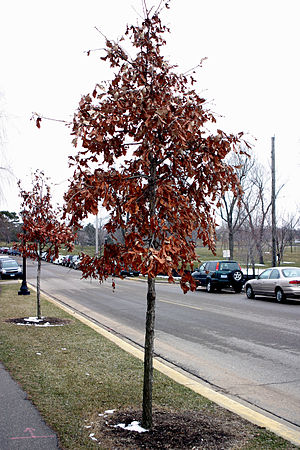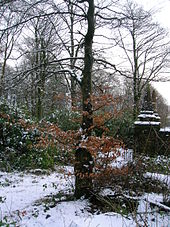- Marcescence
-
Marcescence is the retention of dead plant organs that normally are shed. It is most obvious in deciduous trees that retain leaves through the winter. Several trees normally have marcescent leaves such as oak (Quercus)[1], beech (Fagus) and hornbeam (Carpinus). Marcescent leaves of pin oak (Quercus palustris) complete development of their abscission layer in the spring.[2] The base of the petiole remains alive over the winter. Many other trees may have marcescent leaves in seasons where an early freeze kills the leaves before the abscission layer develops or completes development. Diseases or pests can also kill leaves before they can develop an abscission layer.
Typical partial marcescence on a mature beech (Fagus sylvatica) tree.
The term "marcescent" is also used in mycology to describe a mushroom which (unlike most species, described as "putrescent") can dry out, but later revive and continue to disperse spores.[3] Genus Marasmius is well-known for this feature, which was considered taxonomically important by Elias Magnus Fries in his 1838 classification of the fungi.[4]
Benefits
One possible advantage of marcescent leaves is that they may deter feeding of large herbivores, such as deer and moose, which normally eat the twigs and their nutritious buds. Dead, dry leaves make the twigs less nutritious and less palatable.[5]
Marcescent leaves may protect some species from water stress or temperature stress. For example, in tropical alpine environments a wide variety of plants in different plant families and different parts of the world have evolved a growth form known as the caulescent rosette, characterized by evergreen rosettes growing above marcescent leaves. Examples of plants for which the marcescent leaves have been confirmed to improve survival, help water balance, or protect the plant from cold injury are Espeletia schultzii and Espeletia timotensis, both from the Andes.[6][7]
References
- ^ Berkley, Earl E. 1931. Marcescent leaves of certain species of Quercus. Botanical Gazette 92: 85-93.
- ^ Hoshaw, R.W. and Guard, A.T. 1949. Abscission of marcescent leaves of Quercus palustris and Q. coccinea. Botanical Gazette 110: 587-593.
- ^ See introduction to Roy E. Halling "A revision of Collybia s.l. in the northeastern United States & adjacent Canada" Inst. of Syst. Botany, The New York Botanical Garden, Bronx, NY 10458-5126
- ^ E. M. Fries Epicrisis systematis mycologici (1838) Uppsala: Typographia Academica
- ^ Svendsen, Claus R. 2001. Effects of marcescent leaves on winter browsing by large herbivores in northern temperate deciduous forests. Alces 37(2): 475-482.
- ^ Goldstein, G. and Meinzer, F.1983. Influence of insulating dead leaves and low temperatures on water balance in an Andean giant rosette plant. Plant, Cell & Environment 6: 649-656.
- ^ Smith, Alan P.1979. Function of dead leaves in Espeletia schultzii (Compositae), and Andean caulescent rosette species. Biotropica 11: 43-47.
Categories:
Wikimedia Foundation. 2010.


